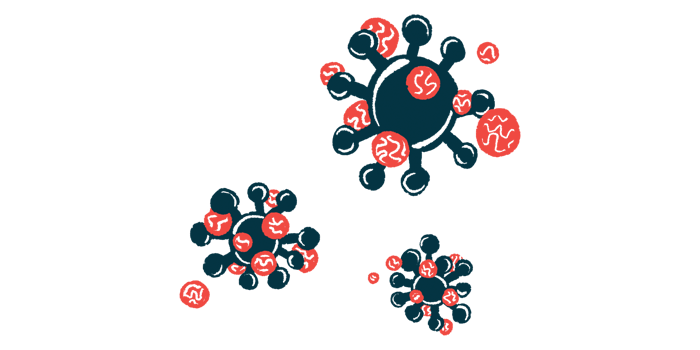Virus-like protein needed for healthy placenta also may promote ALS
PEG10, unless able to degrade, seen to build to levels that kill motor neurons

PEG10, an ancient, virus-like protein that supports the development of the placenta, appears to also participate in the nerve cell loss associated with amyotrophic lateral sclerosis (ALS), researchers discovered.
ALS-causing mutations in the UBQLN2 gene were found to prevent the proper degradation of PEG10. This led to a PEG10 buildup that changed the activity of genes involved in the health of nerve fibers, “linking PEG10 dysregulation to neuronal dysfunction,” the researchers wrote.
“Our work suggests that when this strange protein known as PEG10 is present at high levels in nerve tissue, it changes cell behavior in ways that contribute to ALS,” Alexandra Whiteley, PhD, the study’s senior author and an assistant professor in the department of biochemistry at the University of Colorado Boulder, said in a university press release.
This work also showed that PEG10 was abundant in tissue from patients with sporadic ALS, the most prevalent form, and those with familial disease.
ALS research suggests protein is a potential root cause of the disease
Whiteley and colleagues now are investigating the underlying molecular pathways and ways of suppressing the rogue protein through funding from the ALS Association, the National Institutes of Health, and Venture Partners.
“It is early days still, but the hope is this could potentially lead to an entirely new class of potential therapeutics to get at the root cause of this disease,” Whiteley said.
The study, “UBQLN2 restrains the domesticated retrotransposon PEG10 to maintain neuronal health in ALS,” was published in the journal eLife.
In ALS, the death of nerve cells that control muscle movement, called motor neurons, results in the progressive inability to perform everyday tasks.
Mutations in the UBQLN2 gene, which encodes for the ubiquilin-2 (UBQLN2) protein, are known to cause familial ALS, which accounts for about 10% of all cases.
UBQLN2 is a member of a family of proteins involved in the degradation of misfolded and unused proteins. Unlike other ubiquilin-family proteins, UBQLN2 is uniquely enriched in nerve and muscle tissues.
Research suggests that a defective UBQLN2 protein causes a toxic buildup of cellular waste, leading to the death of motor neurons in patients.
Using ALS animal models, Whiteley and colleagues previously discovered that UBQLN2 defects cause a marked accumulation of the domesticated retrotransposon PEG10 protein in brain tissue.
Domesticated retrotransposons are viral genes in human DNA that are the result of ancient viral infections. While encoding virus-like proteins, these viral genes have lost the ability to infect other cells and taken on new functions.
Virus-like activities of PEG10 could help to drive neurodegeneration
In particular, the PEG10 protein is essential for the development of the placenta in mammals. However, a recent study also implicated PEG10 in the neurological disease called Angelman’s syndrome.
“Domesticated is a relative term, as these virus-like activities may be a driver of neurodegenerative disease,” Whiteley said, adding that “in this case, what is good for the placenta may be bad for neural tissue.”
To determine whether PEG10 is associated with human ALS, the team analyzed the protein content in spinal cord tissue collected from 19 deceased ALS patients and 11 unaffected people serving as controls.
Patient samples, provided by Target ALS, were mostly from sporadic ALS cases, except for one patient carrying a disease-causing UBQLN2 mutation.
Results showed that among more than 7,000 unique proteins, PEG10 was significantly enriched in ALS samples compared with tissue from healthy controls.
Researchers then deleted the UBQLN2 gene in lab-grown human cells to understand the molecular relationship between UBQLN2 and PEG10. Only cells lacking UBQLN2 showed increased PEG10 levels, while those with a restored UBQLN2 protein could control PEG10 levels.
Similar results were seen in lab-grown cells carrying a known ALS-causing UBQLN2 mutation.
Further experiments confirmed that UBQLN2-deficient cells could not correctly break down PEG10, leading to its buildup.
“It appears that PEG10 accumulation is a hallmark of ALS,” said Whiteley, who recently obtained a patent for PEG10 as a potential diagnostic biomarker.
Potential seen for new ALS treatments targeting the PEG10 protein
PPR, a small region that is present in PEG10 only in ‘placental’ mammals, also was found to be essential for UBQLN2-dependent PEG10 degradation by the cell. The fact that both PPR and UBQLN2 exist only in mammals requiring a placenta for fetal development suggests an “evolutionary relationship,” the researchers wrote.
Finally, the scientists showed that PEG10 was able to cleave itself into protein fragments, some of which moved into the cell nucleus, where all the genetic information is stored. There, these fragments altered the activity of genes, particularly those involved in the development of nerve fibers.
“Additional studies are required to determine the precise contribution of PEG10 to the [gene activity] changes observed in ALS tissues and to in vivo [in living animals] neurodegeneration,” the researchers wrote. “Ultimately, further understanding of PEG10 biology in the context of ALS, as well as other conditions where PEG10 is elevated, may provide novel avenues for therapeutic development.”
PEG10’s likely contribution to disease “means we may have a new target for treating ALS,” Whiteley added. “For a terrible disease in which there are no effective therapeutics that lengthen lifespan more than a couple of months, that could be huge.”







